

At least I didn’t have to live on these.
I was like a man released from a prison of grilled cheese. Which is to say, if you noticed the ton o’ stuff I had at the Reader last week, and I do hope you watched all three of the videos and read my two pieces, thankyouverymuch, you can probably guess that the life of someone writing/editing video about food occasionally gets too busy to actually enjoy food in. I spent a solid week hardly eating anything more interesting than grilled cheese or salad or delivery pizza, so when I was finally done, or close to, I devoured the world. Or at least it felt like it. Herewith, some not too lengthy notes on what I had:
Owen & Engine
My second visit and the first where, having someone else to share with, I felt I could order the charcuterie platter and not come out of it feeling like I’d huffed down a whole Oscar Mayer lunch loaf by myself. I really like the beer list at O&E, especially since you can consult with the bartenders (at least on a Tuesday night) on your choices in the hushed, detail-oriented manner of a meeting with a financial planner. (I feel it’s important to maintain a diversified portfolio which goes from darker to lighter beers as the evening progresses. Past performance is no guarantee of future results.) I’m also amused by the sudden popularity of cask engines, which is to say, really fresh but decidedly flat beer. Someone somewhere is a genius for marketing flat beer as the latest, coolest thing.
Anyway, after two visits, I think even moreso what I thought after one visit. O&E may not be the culinary trendsetter that Longman & Eagle is, but everything’s friendly and solid, and the atmosphere perfectly evokes its model (which may be more faux-English pubs in Old Town in the 70s than actual England, but that’s fine by me). The charcuterie plate had an excellent hard salami of some sort (I forget what) with big dice of fat in it, a pretty good rillette and beef heart pate, and an imported Spanish ham. A nice plate, though pushing my price tolerance at $19. Closer to a perfect intersection of price and flavor was the rasher and egg sandwich, thin English bacon (more like ham) fried with egg on a crusty bread, with excellent fresh-cut fries. I really liked the roasted bone marrow, too, though it was marred by a couple of executional oddities— one, I had a bone with a center too small for the marrow spoon, which took some wiggling and jabbing with a knife to eat; two, we had to ask for, and were I think charged for, toast points, which in any case took long enough to come that we had pretty much devoured the marrow by then. Bone marrow and toast points, I thought that was one of those combinations that went without saying. (They do have housemade bread, by the way, which is pretty good. Maybe that’s why they’re a little close with it, though.)
I’ve never had a regular bar of my own— in fact, I think it’s somewhat important not to, at least when one had far too many relatives who demonstrated the perils of having one— but I think O&E has dislodged me from the sloth of hitting the ordinary sports bar near me for a beer and a quickie meal, the same meal every time, and convinced me that on those nights, a short drive down Western is worth significantly better food, beer and atmosphere.
Three Floyds Pub/Munster Donuts
The next day I was shooting at Three Floyds in Munster, Indiana— my first visit ever to their pub, which is hidden, like the brewery, in an industrial park which must wonder what the hell is going on when it’s overrun every year for Dark Lord Day. Mike Sheerin, who won a Food & Wine best new chef thingy at Blackbird just last year, is now consulting there while working on his own project, and seems to be trying to upgrade the food at Three Floyds, which I gather from LTH threads has been on a bit of a rollercoaster ride over the years. (Another relatively recent hire in the kitchen is charcuterie blogger Saucisson Mac, so it was good to have a chance to meet and talk with him for a bit.)
You’ll have to wait for the Key Ingredient video on Thursday to see what Sheerin made for that, but we tried some of his first dishes for Three Floyds and were really happy with them. He said the potatoes in the bangers and mash had hops in them; if so, it was very subtle, but the bangers and the refined-tasting gravy were quite satisfying. We also had some mussels with lots of excellent housemade bacon, and a charcuterie platter with a terrific goat knackwurst and housemade mortadella, among other things, which went for a princely $8. At those prices, how can you not make the 45-minute shlep to Munster, Indiana for Sheerin’s high-low comfort food in Three Floyds’ gleefully low atmosphere? Especially when you know you can grab a dozen at Munster Donuts (8314 Calumet Ave.) on the way back to the highway— Bavarian Kreme not so great, but chocolate, cherry (rare in these parts) and sour cream all first-rate and cheap.
Balkan Restaurant
After meeting with Cathy Lambrecht about an upcoming event I will be part of (details to follow, sometime), I had hopes that my meat-and-beer-centric week so far would give way to a largely vegetable-based lunch. So we wound up trying a Balkan spot in a strip mall to eat this:

I’m pretty sure I had been to Balkan (2321 W. Lawrence) before, I remembered the big stone oven dominating the middle of the bright and clean room, but it had been a long time. I think somebody at LTH posted years ago about it being run by a one-armed woman, but the man in charge now seems to be a tall and slender fellow who was surprised at Cathy’s knowledge of Balkan cuisine. (I checked the kitchen but the woman working in there was definitely two-armed.) Anyway, the difference between cevapcici sandwiches is not all that great, but I thought these were above average in beefy flavor, and the spinach and cheese burek was very good; it’s also rare enough to find a Balkan place that’s truly welcoming and willing to interact with the non-Balkan customers that that’s worth calling attention to, too. If Deta of Deta’s Montenegrin Cafe ever does move back to Montenegro like she’s threatened to, this will do.
Perennial
I was about ready to go back to grilled cheese, or at least a salad, but at the last minute I got invited to dinner at Perennial by their PR person, and joined a couple of other media folk in a low key tasting of new things at Perennial… praying that it wouldn’t be a special Kobe/pork belly dinner. I don’t think it’s the freebie that made this the best dinner I’ve had there, since the last time I ate there was a freebie too. In that case I thought there were some executional issues and Boka, which we also visited that night, came off the better of the two.
So it’s a pleasure to report that dinner was not only executionally flawless but contained a number of things that really impressed me and definitely pushed Ryan Poli up a few notches in my book. It was more of a social event, so I don’t remember it course by course, but I came away especially impressed by three things. One, the fish courses— fish is too easily boring (grill it and put it on top of something julienned) but we had three fish plates, all of which were surprising and pleasing. The first was probably the funniest— a deconstructed fish taco consisting of hamachi sashimi, with avocado and corn tortilla purees. Okay, so we just saw the Top Chef in which the guy who foamed everything went home, and Tony Bourdain ranted about how passé that kind of deconstruction is. But a good dish can get away with anything, and the exquisite delicacy of the velvety hamachi combined with an ethereal blob of airy puree that, by God, really did taste like a bag of El Milagro tortillas, all summed up as “fish taco,” was a grand joke. The fish entrees weren’t tongue in cheek like that, but a beautifully oil-poached cod in a sweet onion broth was also one of the most complex yet easy to like fish dishes I’ve had.
Another thing we tried, that I thought sounded like dumbed-down fine dining but came off surprisingly well, was a trio of Mac and cheeses. One was styled on fettucini alfredo, with housemade guanciale and a quail egg yolk (my favorite); one was built off of duck confit (I was not so sold on this, but others were) and one, “My girlfriend’s vegan mac,” was quite surprising, with a sharp, funky flavor that had us all guessing Asian ingredients like seaweed or MSG; it turned out to be mainly nutritional yeast and paprika, with some other things including soy thrown in.
Finally, I’d wondered about the desserts at Perennial and Boka since Elizabeth Dahl, who was their dessert whiz, left with her husband to start Nostrano in Madison a few months back. I don’t know who does them now, but they’re similarly playful and fun, a cheesecake in a glass consisting of cream cheese foam with graham cracker ice cream or a vanilla and strawberry parfait with strawberry Pop Rocks. All in all, a clever and delightful meal that, heck, I’d even pay my own money for next time.
In association with the Chicago Reader, I go behind the scenes of the opening of a new restaurant, Leopold. Read the print piece and watch the video.
* * *
As noted earlier in the week, a weird convergence of events means that this week’s Reader has two articles and three video pieces by me. First up, of course, is this week’s Key Ingredient, in which Brian Enyart, chef de cuisine at Rick Bayless’ Topolobampo, wrestles with sticky, icky, very Japanese natto:
Next, a big feature piece on a new Belgian gastropub, Leopold, and since I video’d all my interviews along the way, there’s a 9-minute video attached as well:
Finally, short and sweet in more ways than one, a blurb on a bakery, Chimney Cake Island, offering a unique Romanian treat, and the totally cute couple who run it:
The things I’ve made most recently are all media: three videos and two articles for this week’s Reader, to be precise. (Kate Schmidt, the food editor, joked that this week would be the special Michael Gebert issue.) So as far as blogging here goes, I’m just going to cover it off with a few pics of things I made to eat at home around the holidays:
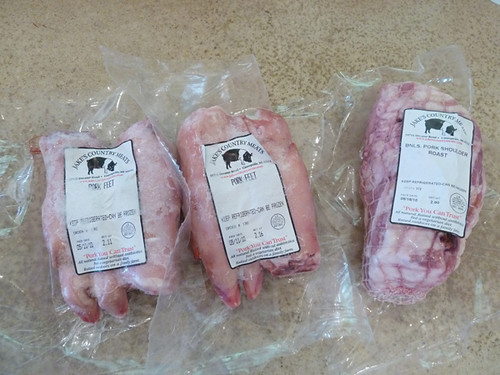
1. Pork Head & Parsley Pate, from Pork & Sons.
When I reviewed James Villas’ Pig a few weeks back, Mark S., who blogs about charcuterie here (and is Msmre on LTHForum), mentioned the book Pork & Sons as his favorite of the current crop of porky books, so I added it to my Amazon wish list just in time for my birthday. I have to admit that until then, I had overlooked it purely because of its pink gingham cover. A French import, it’s kind of the Amelie of French meat books, awfully pleased with how cute and quaint and Fffronsh it is. Still, it does indeed seem solid and evocative of a certain style of eating worth preserving.
Wanting something for a Christmas dinner starter, I decided to make this pate— really, a headcheese. I contacted the Jake’s Country Meats folks, who sell at the Logan Square Farmer’s Market, and asked for whatever they had of the cuts the recipe listed: a head, two trotters, and some shoulder. Well, they were all out of head, but I got the trotters and the shoulder, diced up the appropriate amount of the latter, and set it to cooking with some aromatics and vegetables:
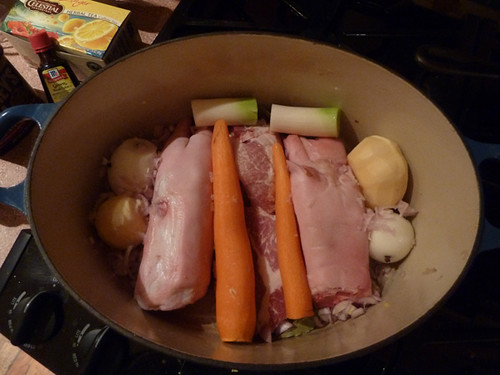
One thing to note about pig’s feet— there’s no meat on them. I don’t mean “hardly any,” I mean zero— all you get from them is the gelatin. The meat was all from the shoulder. When reduced to tender chunks, I diced it up and laid it in the terrine:
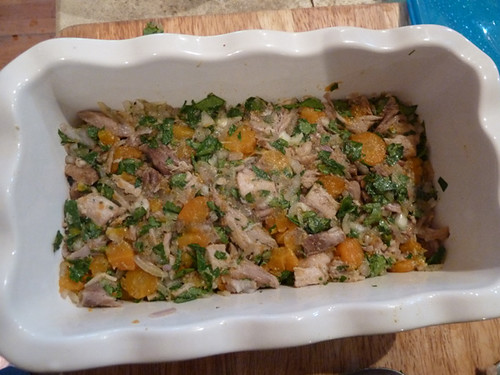
One thing I remember Rob Levitt said when he was demonstrating making testa was that you should salt and season it heavily, since it will be eaten cold. Meanwhile I reduced the gelatinous broth to a truly shimmery thickness, and poured it over the packed meats and vegetables:
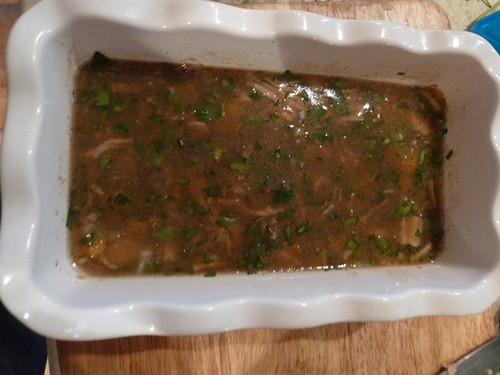
A couple of days to set in the fridge, and:
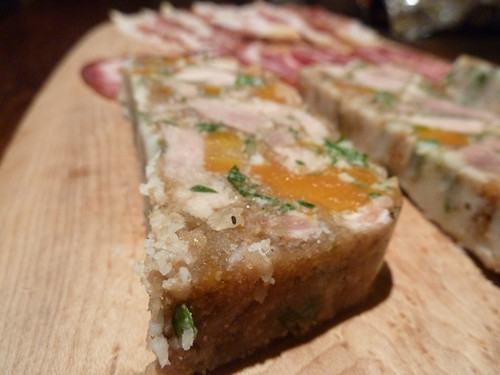
I really liked this pate, it’s full of flavor (and not just meat, either), though I think I need to buy a smaller terrine for such exercises— I’m the only one who eats this stuff, generally, and it didn’t get completely finished, sad to say.
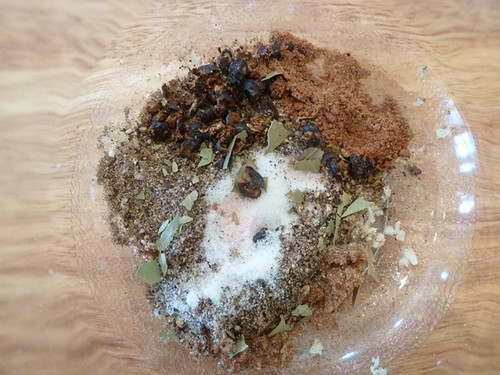
2. Pancetta, from Charcuterie.
At the same time I got three decent-sized strips of pork belly from Jake’s. Two were destined to be bacon, but I decided to experiment with pancetta with the other, having loved my pancetta from Bolzano Artisan Meats in Milwaukee. I mixed up the spices and curing salts, coated the belly and sealed it away for a week…
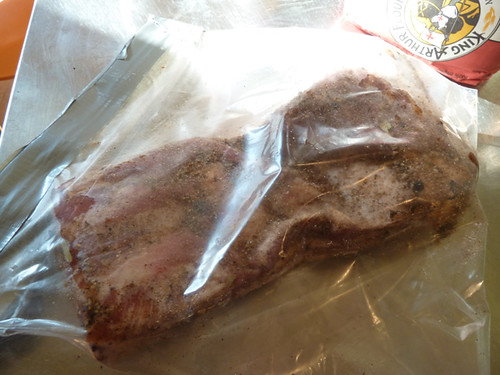
After a week I cleaned it off and cut it in half. I wrapped the pieces in cheesecloth and hung them in my wine fridge:

A week after that I took one piece out to try some and use it on a pizza. The meat had only lost about 10% of its weight, and what I realized was, although this soft, supple meat had the texture of most pancetta you buy, and tasted fine, I really preferred Bolzano’s, which I suspect is both more heavily salted and more aggressively dried. So I’m going to try drying at least one piece more, even at the risk of spoilage, and see if I get closer to what I liked about theirs. If it goes bad, well, I learned something.

3. Great Grandma’s Suet Pudding, Marjorie Zalewski, Toledo, Ohio (3rd Place, Ohio State Fair Family Heirloom Recipes Competition)
I was of a mind to make a traditional Christmas pudding this year. Cathy Lambrecht mentioned that she had posted one that had won a prize in a contest at the Ohio State Fair at the Greater Midwest Foodways Alliance site.
With such simple beginnings do many epic sagas start.
The recipe looked like just the thing— old-fashioned flavors like molasses, suet as the primary fat, and so on— so, being of a mind to get whatever I could out of the way before the big day, I mixed it up (making cranberry relish at the same time on the top of the stove), grated the suet myself from some beef fat I’d bought at Paulina Meat Market, and baked it in a bain-marie for three hours. At the end of which, opening the Jiffy Pop-like aluminum tent, I found that it was… flat. Very flat.
I studied the recipe for clues. It didn’t take long: carelessly I had used baking powder where more inflationary baking soda was called for. It was now about eight o’clock on Friday night. If I hurried and actually paid attention this time, I could just get a second one baked by midnight. This is how I spend Friday nights, folks.
The second one went in. Meanwhile, I tasted the first. It tasted… authentic. With nothing but molasses for sweetener, it was very 19th century, very hardscrabble life on the Plains. It tasted like Christmas… in a Willa Cather novel.
I decided I couldn’t end Christmas dinner with a dessert that no one liked. Notably, my children. So the next morning I started making an apple-lemon curd dessert with Sauternes— if the first dessert was Willa Cather, this one was Schnitzler, Toulouse-Lautrec, Debussy, Continental elegance with a touch of the dandy and of the decadent.
Christmas dinner came. I advised my guests that no one would take it amiss if they had one bite of the prairie dessert and then devoured the other. But, in fact, Grandma Zalewski had a trick up her sleeve— it may not have been the case in 1840, but by the 20th century when she was passing this one down, it came with a brandy hard sauce full of sugar, which lightened and leavened the dense, molasses-y darkness of the pudding. It was still substantive, but no longer ponderous. The clash of dessert worlds became a fair fight, and in fact, both were eaten with considerable pleasure (not to mention the rest of the Sauternes). In the end, Cather and Schnitzler together produced a last course out of Dickens, leaving us full and full of good fellowship. It’s important to know how to keep Christmas, after all. Ask a famous author.
Andrew Zimmerman of Sepia does lamb fat in the new Key Ingredient (read it here). Big props to him, since we had some technical issues and he was a real standup guy about helping us out and getting it done.
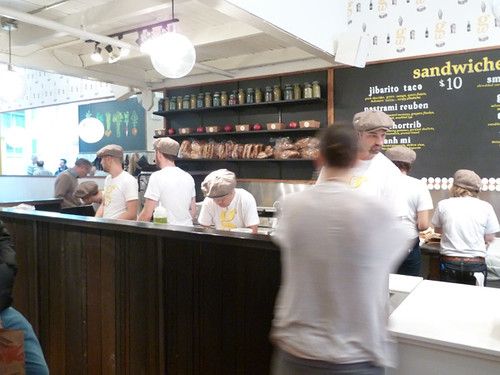
To do this properly, I need to get the veggie wrap, but— shortribs? Smoked whitefish? Those sound so much better. Lunch wins out over the needs of the blog… I’ll just snap a few candids while I wait…
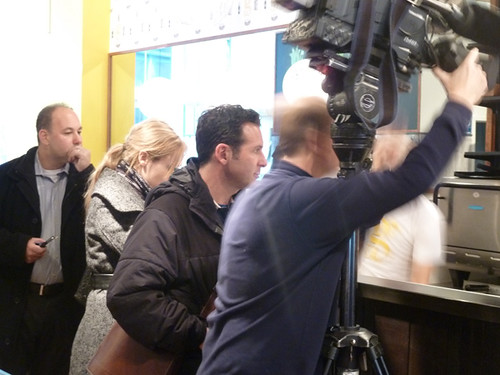
I’ll take it to the seating in the back, there’s natural light— oh hell, some other guy’s already shooting there.
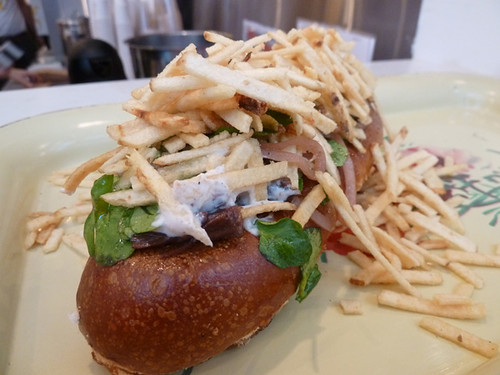
Shortrib it is… looks great… you can hardly see the meat though. I’ll move some of the shoestring potatoes in front…

There’s the meat. Let’s try an arty angle…
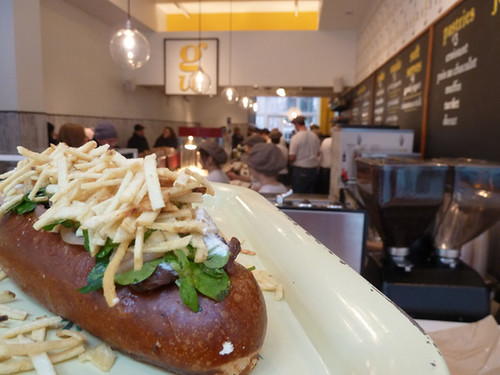
Or one that puts it in the context of the store…

Or the context of the dining experience… no, that’s not it. What I need is natural light, to really give it three-dimensionality and some dramatic contrast of light and dark. Turn on the macro, too.
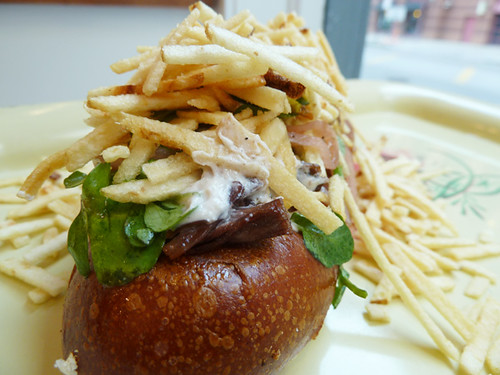
Perfect! Now that’s how you photograph a Grahamwich!
(If none of this makes any sense to you, read this.)
So I read on the blogs that Graham Elliot was in Paris. Aha! My perfect moment to visit Grahamwich without risking a thrashing from a Texas bullwhip. So after shooting an upcoming Key Ingredient, I walked over, ordered a shortrib sandwich, and waited. As soon as I snapped the candid at top, the manager noticed me. It quickly became clear that he knew who I was, and the backstory of why I was taking photos. “Why, is there a Wanted poster in the office with my face on it?” I asked. He laughed, and when my sandwich arrived I was treated to chips and a drink on the house. (The chips, dusted with cheese and chives I believe, are very tasty, but the portion is huge, we’ve been munching them for two days at home— you could easily split among two if not three or four at lunch. The housemade orange soda was first-rate, too. It’s easy to drive your lunch bill to $20 with these things, but at least they’re really very good.)
I went up front to get natural light, since Steve Dolinsky was hogging the back getting B-roll for an interview he did earlier— I’m in some of it, trying to be practicedly casual in how I eat my Grahamwich. (It was actually a big media/industry day— Julia Kramer of Time Out popped in as well, and so did a chef from Longman & Eagle. Hope they get regular customers too.) The manager offered me a new vintage tray to shoot on, and dressed my sandwich with some extra shoestring potatoes. No glycerine or other tricks of the commercial photography trade, though. Several more tries, and— in the end I had a shot that I thought demonstrated how good a picture you could take and still be an amateur with a pocket camera taking no more than a couple of minutes to get your shot.
So how was the sandwich? Shortrib’s an easy layup, to be sure, always comfily ingratiating, and if they couldn’t get that pretty right it would be shameful; but you have to balance what you put on it, too many sandwich places smother good meat under creamy sauce or overdo the bread (pretzel roll, probably LaBriola). This was a really well-balanced sandwich, well, apart from the extra shoestrings for visual effect, surely 2-3 times the normal amount. And I was impressed to see the staff working furiously not only making the sandwiches, but remaking some of the toppings as we watched, in order to ensure that everything was as fresh as could be. I’m eager to try more… as soon as I find out Elliot’s out of town again.
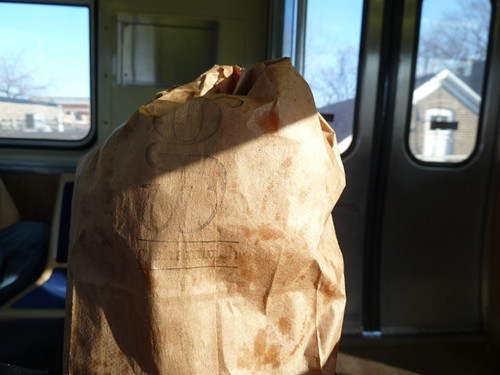
ADDENDUM: See here. Elliott is probably being a bit sarcastic about little old me, but all I can say is, blogging may be a smalltime thing but it’s on the level: the photo wasn’t good, the sandwich was, and I said both honestly at their respective times.
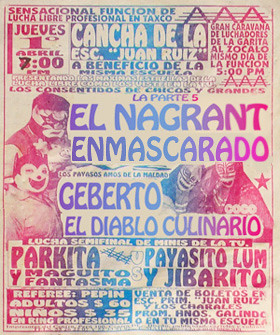
Continued from Part 4 here, not to mention parts 1, 2 and 3.
MICHAEL GEBERT: It’s our last day, and we have a couple of questions from the commenters (thanks, folks) as well as every other subject that has anything to do with food to cover here before I run out of pixels. So let’s buzz through them, although of the things everyone will expect us to cover, there are at least two that I just can’t work up any energy to talk about again— Michelin and food trucks. But don’t let my ennui stop you.
Let’s start with another very recent and much talked-about controversy‚ a restaurant called Red Medicine in Beverly Hills outed the L.A. Times’ S. Irene Virbila in a particularly nasty fashion— posting her picture (of which all I can say is, my mom should go eat in Beverly Hills, she looks enough like her to get great service next time) and refusing her service. I’m firmly of two minds about this. On the one hand, I don’t care if Hitler comes to eat at your restaurant, it’s not good business to get known for embarrassing customers in public, especially in a place like L.A. where many of your richest and most powerful customers are, indeed, famously loathsome. There’s a way to fight back against critics with panache, and treating customers rudely isn’t it. (For instance, it would be hilarious for some restaurant to publish a review of the reviewer’s behavior at table, written in mock reviewer-ese.)
But I’m not entirely sorry if the fiction of anonymity for such long-running reviewers took another hit. I saw at one restaurant the board with all the major critics’ mugshots on it that’s right as the servers exit the kitchen, I’m sure you’ve seen similar. Recognition must happen all the time, at least at the high end. But as we talked about last year, it’s just one part of how the whole review system is sort of stuck in the past. There was an example of that this year that really struck me. When it was announced that Mike Sheerin was leaving Blackbird, Phil Vettel let it drop that he had been to Blackbird recently, presumably for an upcoming review of Sheerin-era Blackbird— the first review of that most important and influential restaurant in over a decade. Which now wasn’t going to happen, obviously, since the chef it was about was leaving. What, you couldn’t have blogged a couple of things you really liked in the interim, Phil? You sure can’t write that review now. This idea of sitting on your visits to Blackbird until you can craft the perfect comment on it for the ages— it’s so out of step with the speed the food scene moves at these days, as indeed it proved in this case with the chef change. (Just imagine if he tried to review Va Pensiero!)
NAGRANT: Most of the people who’ve argued that pursuing anonymity is worthless or silly or antiquated are people who never seriously pursued it in the first place. They are people who often derive their self-importance from being insiders or doted upon by the establishment. These folks who often know in their heart that they are freeloading sycophants and so they wish mightily that the establishment would justify their actions by declaring anonymity dead.
GEBERT: But I’m not a critic… I suppose that’s the first reason we have a different attitude about it. Obviously if you’ve looked at my blog I post reviews of whatever I’ve eaten lately, but that’s as much a way of taking notes and organizing my thoughts as anything; I don’t think I’ve been paid for anything like a review in well over a year, it’s all been feature writing of some sort, which is more interesting to me. I understand why you say that the market for that has dried up— certainly at the moment the full-time jobs that have been open have all been for the inside news blogs, Grub Street, Eater, Feast, etc. firing off short newsbites all day But I think that’s a short term function of the advertising environment as much as anything— they can get lots of hits in a day, and keep people coming back to see what’s new day after day. But that can’t be the only model for food content online, it’s too narrow and now-focused to be the only kind of food writing there is; people want other things too even when there’s no successful content model that proves the fact (except, maybe, books, which remain unkillable no matter what technology throws at them, proving there’s a primal need for intensive one-on-one engagement with a writer, even with the reader’s own money). But we could just as easily have a different model tomorrow that sells whole articles for 25 cents for the Kindle, or in which Grey Goose Vodka sponsors them or something, and then the longer, meatier piece will be more marketable again.
And I think for journalists, you need to go not only where the traffic is but where your strengths are; the review is devalued because everyone can do it, for free. (Do it, not do it well, of course.) But the in-depth piece of reportage— a blogger can do this, but it’s exponentially more legwork (I stopped telling people how long it took me to put together each Sky Full of Bacon video, because I was tired of the “And you’re not getting paid for that?” look), and benefits from having the institution behind you in terms of getting your calls taken, and so on. Anyway, I’m convinced that if the market’s dried up for longer, more interesting pieces, it’s not because there’s no market, it’s because the market and the demand are still sorting each other out, and now’s the time to be one of the people inventing the new forms.
Okay, let’s take a question from the comments. Kennyz posited his views on the malign influence of PR firms on Day 1:
2010 was the year of the Public Relations professional. Last year’s chatter was all about who would win the food media wars – traditional outlets or bloggers and discussion forums. Meanwhile, as those peons were battling their esoteric arguments out, PR firms were figuring out how to take control of it all, and they succeeded big time. As we enter 2011, whether it’s a random LTHForum poster writing about a great dinner at Ampersand & Ampersand, a Michael Nagrant tweet to hundreds or thousands of followers, or a feature article in the Chicago Reader, there’s a damn good that it emanated from a carefully orchestrated campaign put together during a brainstorming meeting in some corporate office with a whiteboard and a tray of Corner bakery sandwiches in the center of the table.
My feeling is we really answered this on Day 3, talking about Grahamwich. I don’t think there’s anything sinister, or even moreso, that there’s anything new about PR people pitching stories to publications; the publications seem to have the upper hand on what they go for or not and even when they go for a pitch, the ability of the PR firm to direct it from that point is so minimal. I’m working on something right now which started with a pitch from a PR rep, but other than keeping me up to date of the restaurant’s progress toward opening, the PR person has had nothing to do with the shape of the story.
The real change, I believe, is that chefs are taking over the process— and they’re much more likely to be mercurial about how access is granted. I think it’s worth remembering what happened with movie journalism in the 80s. A few stars with ties to a few big agencies like CAA became so central to magazine covers that produced newsstand sales that they got the upper hand and were able to say, you bring up Scientology in your Tom Cruise piece and you not only never get Cruise again, you don’t get all these other stars I represent either. And they gutted magazine movie journalism in that decade; Premiere started out as a glitzier Film Comment and ended the decade as Us (and soon died), and they blacklisted certain writers, and all kinds of things. That’s way more intrusive than anything that ever happened with Sidney Falco pitching J.J. Hunsecker an item for the column at Sardi’s. (The difference is, this time there will still be blogs out there like cockroaches, surviving and publishing everything.)
NAGRANT: Well, I like KennyZ. I’ve appreciate his posts on LTH and to some extent, he’s right, PR people do have more tools at their disposal to push their messages and they’ve found backdoor channels to push their messages. I mean, yes I do sometimes RT chefs directly or to a lesser extent, PR people. While he can’t see the lust in my heart – let me assure him that I only RT things I’m generally interested in and not because I’m trying to curry some favor. I’ve been critical of Graham Elliot this year and I even made a joke at Rick Bayless expense regarding the old BK commercials – that’s not something you do if you have some kind of calculated need to suck the teat of monster PR.
GEBERT: And of course Ellen Malloy’s new model is the opposite of the PR person carefully planting stories, it’s to create a place where chefs can nail stuff to a wall for journalists to find and get inspired to do a piece by. It’s hands off, giving the chefs an open field to prove to be interesting, or not. (Which does mean that the chef with lots of innate personality who makes good copy becomes more important than ever without a PR person smoothing the path for them. We’ll see in ten years if that meant the food got better, or merely that the chefs got more famous.)
Another question from the comments. An anonymous commenter asks:
What are your thoughts on the Chicago brunch scene? It seems our city more than others has valued the trendy brunch place in the past. Solidly entrenched tradition, or fad on its way out?
Here we’ve run into one of my areas of ignorance; my kids get me up early enough on Sunday morning that by the time those trendy restaurants roll out of bed and start serving mimosas at 11, we’ve been fed for two hours already. Your thoughts?
NAGRANT: I definitely don’t get to brunch as much as I used to. However, I can say the real solid contenders in the category the last couple of years like Meli Cafe, Stax in Little Italy, Publican, and Jam have really focused on high quality either classics or solid gourmet twists over trendy Butterfinger candy bar larded pancakes. Then again I still love me some Bongo Room (South Loop location) as much as the next guy. I mean I think as long as you have Sex and the City movie sequels, hung over people, old people with no kids and lots of money and time, and young Chicago transplants who never went to bed the night before, there will always be a demand for brunch.
GEBERT: Final question, same as last year: tell us something fantastic to go eat right now.
NAGRANT: Todd Stein’s caramelle pasta at Florentine. If you’re adventurous, the maatejeering (i’m sure this is spelled wrong, but I’m too lazy to brush up on my Dutch) shot at Vincent, and for good karmic measure, everything in the pastry case at Pasticceria Natalina.
GEBERT: Florentine, I hear that place has an atmosphere like a glorified airport lounge/faux library/garage sale art gallery, but the pastas are good. My recommendation, which it has been to everybody for the last couple of months, is Taza Bakery in a sketchy little strip mall at 3100 W. Devon. They have the best beef shwarma in town at the moment, but they also bake all kinds of stuff like spinach or potato pies, and they make these great big puffy breads called tannur that are dirt cheap and great to use like Boboli as a pizza crust. Check it out.
Thank you for joining me here again to solve all the food world’s problems; thanks to all our commenters for their intelligent and pointed observations, to everybody who linked it, and to all the readers and Twitterers we picked up along the way. Read Michael Nagrant in New City every week and Chicago Social. As for me, you’re already here, but be sure to read (Julia Thiel) and watch (me) the Reader’s Key Ingredient every week; the latest one (Paul Virant and spirulina) is here. And there will be a continuation of the Grahamwich-photo kerfuffle on Monday… come back and see.
Paul Virant and a nutritional supplement from the 80s star in the Reader’s latest Key Ingredient; read the piece here.

Continued from Part 3 here, and be sure to read yesterday’s comments— some excellent ones in there including from our buddy David Hammond and one from an anonymous server who says I’m way underestimating how annoying foodies can be…
MICHAEL GEBERT: So we ended yesterday talking about Black Dog Gelato, which I’ll happily endorse if you don’t buy Stephanie Izard’s endorsement, and the tendency of chefs in the media to follow what I used to call the Paradise Sauna Paradigm. Which is, the media would ask a chef where they like to go eat when they’re off work, and the chef doesn’t want to give business and props to direct competition, so he picks some place that poses no threat. Which somehow usually seemed to work out to be the late Paradise Sauna on Montrose for sushi. (Hey, it was open late, and… well… who knows what else it may have offered.) So yes, there is this paradoxical thing of people wanting info straight from the chefs, forget the media gatekeepers, they want that connection to the chef’s knowledge… even when they know they’re getting an answer that’s good politics for the chef. (Paul Kahan says he loves to eat at Avec or Big Star!) But hey, there may be a rational calculation there on the part of readers that even a calculated answer is closer to the insider knowledge that everybody wants, than some publication’s “Ten Places You Must Eat Char Siu Now” listicle which is totally generated out of some 20-year-old intern’s Googling.
Anyway, that’s my roundabout way of getting out of the fine dining sphere and into talking about more casual food, not that much of our talk about fine dining hasn’t been about how it’s becoming increasingly casualized. How do you feel about the under $20-a-plate scene in the last year? For me, one big story was that— in a cosmic joke on Kevin Pang, who had just stopped doing his video segments about them— Chicago finally became a pretty good burger town. I wasn’t that wild about the chains that opened, from Five Guys to Epic Burger (though Meatheads out in mallburbia is actually quite good), but of course Edzo’s was an instant classic, this year’s Hot Doug’s, and I was really impressed by DMK Burger Bar, too, for its (successful) use of (admittedly expensive) artisanal meats. And speaking of Hot Doug’s, creative sausages seem to be everywhere, too. So how do you feel about the casual scene?
MICHAEL NAGRANT: But doesn’t Black Dog use corn syrup in their ice cream? Hahaha….foodies.
Do people know they’re getting politically correct answers from chefs? I mean they’re probably all convinced that all chefs do is drink Old Style, eat at Avec, and get the occasional burrito from Taco Burrito Palace #2. Actually, that’s a pretty good picture. Except when they’re on vacation, chefs don’t eat out much because they’re so hard at work late night that everything is closed by the time they get off.
Wait, you were impressed by DMK burger bar? This is a set-up, right? I mean I’m sort of reluctant to say any more than I did in my column because I don’t want Michael Kornick to think I have some weird vendetta. Because, I don’t. But, bottom line is I don’t like the flour top bun. It’s dusty and has a weird mouth feel. In many cases I think the toppings take away or overwhelm the burgers. I didn’t think you could taste the difference in meat or that the patties were made with “love”.
I mean I thought Epic burger – South Loop made a more satisfying a burger (cooked well-done!). Neither excited me anyway. I loved the fries at DMK and the drinks were good. My biggest problem I guess is that Kornick’s MK in the early days was rock solid, and I see DMK as a dilution of the brand. I don’t feel that way about Big Star where Kahan et al have created maybe the best taqueria in town or Xoco, definitely the best whatever it is, hot chocolate stand/torta joint, in town. If Kornick had created Edzo’s, now we’re talkin. I mean I loved M Burger too. They got the bun and the secret sauce right and they make a righteous strawberry shake. Franks and Dawgs is great. All they need is Doug Sohn and they’d have lines down the street.
I was on the fence about Saigon Sisters French market outpost, but I love their lunchtime bao and banh mi at the new spot. Their dinner probably doesn’t fall in to the casual price range, but I’m really happy with what they’ve done. I’d like their Pho to be a little more beefy, but it’s the best we have in the West Loop.
I liked Del Seoul. I think they got the “Korean” taco right for the most part – the seasoning on the meat was righteous, even if the tortillas were just aight.
Davanti Enoteca which is pretty much all reasonably priced small plates was the big surprise of the year. I’ve always liked Mia Francesca and I respect what Scott Harris does, but it is what it is, a place to get really consistent Italian standards and good service, i.e. Lettuce Entertain You like chain level food. Davanti has real personality and a nice convivial neighborhood vibe and really excellent food. If there’s any complaint, it’s that all the poached or fried eggs garnishing the plate will raise your cholesterol to dangerous levels, but that’s pretty much par for dining out anywhere.
I Dream of Falafel is very good and the endless pickled toppings are nice. I’m still waiting for an awesome cheap take-out fast casual Indian spot. Delhi 6 was on the right path, but they closed up faster than a chef who’s been asked about his worst dining experiences of the year.
GEBERT: I kid you not, you need to get back to DMK, maybe they didn’t have their act down yet when you went. It’s one of the few places where I felt like I could really taste the difference of using better meat— Bad Apple is another, the New York-sourced beef is great but I’ve never found a topping combination on the menu that I really liked at Bad Apple, where the first burger on the list, at least, at DMK, the one with fried onions and blue cheese, was dead on and not over the top. (I also like that in both cases, the burger patty isn’t grotesquely huge.) That said, I must admit that I don’t entirely understand the Kuma’s-inspired dress-it-up-like-a-Vegas-stripper mentality toward burgers, or even toward dogs. A sausage with some mustard on it, or a burger with mustard pickle and onion, are pretty much perfect things, time-tested and true; if you’re going to add all kinds of stuff, you really need to make sure you still deliver on the primal snap of the grilled sausage and the bite of mustard and onion on ground meat. I can’t exactly diss Franks and Dawgs considering I’ve been there twice in the last three weeks, but too many of those creations seem so far from the basic, root-level delights of a grilled sausage, so gilded with things that are sweet or vegetably or whatever that isn’t mustard and onion. (Maybe I just need to ask them to actually char mine.) My feeling about gussied-up burgers and dogs is, first, do no harm to the time-tested paradigm of the foodstuff.
Big Star, Big Star… okay, I can understand liking Big Star as a whole package, beer, taco, hipsters going downscale in a rehabbed Phillips 66 with vinyl on the turntable, hot neighborhood location. But as far as calling it the best taqueria in town— I just think settling on one tidy-white place is missing the whole point of Mexican in Chicago, which is that there’s never an end to it, there’s always another place that holds out the promise of greasy, funky discovery. Most will be bad or at least totally ordinary, but then somebody finds a Birrieria Zaragoza or Cemitas Pueblas and, wow. Columbus discovers another new world. That chase is what it’s about, not one moderately solid (it has its good points) place.
That said, Mexican is both the most tantalizing and the most frustrating cuisine in town. I mean, every fine restaurant in town is full of Mexicans, right? How ironic is it that in one of the Key Ingredients I’ve been doing for the Reader, the chef at Blackbird didn’t know how to cook bull’s testicles, so he asked his prep guys and dishwashers and they all did? Every restaurant has two entirely different sets of institutional knowledge inside it, which probably barely communicate with each other. Yet somehow, that exposure to fine dining and the world so rarely seems to translate into a bigger commitment to excellence and creativity in Mexican restaurants. Only Bayless managed to spawn some proteges who could take Mexican to a higher level, meanwhile, all over town the same shortcuts— precook meat before making steak tacos, cook pastor meat in a pan rather than on a cone, etc.— continue to hold Mexican joints back. Isn’t there one guy making $2 steak tacos who realizes he could make $3 steak tacos for gringos with real charcoal and the same meat cooked to order? They’re paying it at Big Star…
I haven’t been to Saigon Sisters’ restaurant, only their French Market stand; I thought the banh mi I had there was fine, but Nhu Lan’s easily beat it. Anyway, as I said in this space last year and also in Eater last week, to me one of the most interesting things on our food scene to me is that we’re getting a younger generation of Asian-Americans who are opening up fun, chic, cartoony, whatever new concepts that break with the traditional Asian restaurant mold which is so tired and shabby-genteel. Ming Hin or Sweet Station may be a little tamer foodwise, a little more gringo-friendly in their flavors, but only a little, and the atmosphere is fun and vibrant. And as people dig into the menus, they’re finding more stuff that’s new and good— I really liked the corn and pork cake at Ming Hin, Rob Gardner recently cited the beef brisket and rice noodle rolls in a pot, and so on.
I hope that outlook and youthful energy will spread to other ethnic cuisines— Indian badly needs to be shaken out of the shabby-genteel buffet mode, too, and there’s at least one kabab/kati roll place that’s kind of a start, J.K. Kabab House. But there ought to be ten wild and crazy Bollywood joints on Devon packed on Friday nights. Korean has potential, too, that’s a cuisine that really needs to break out of its shuttered, Howard Hughes-private dining paradigm and is starting to with the Korean taco thing (though none of the explicit attempts at that have impressed me that much, not even Ruxbin’s). The one cuisine that’s kind of a disappointment is the one that, like Mexican, I would have called one of our local glories five years ago— Thai. Every new Thai place seems to be Ameri-Thai mixed with mid-level sushi. If anybody has opened a place serving authentic Thai food since Sticky Rice or TAC, the word hasn’t reached the gringo foodie community. So for now we just have to keep exploring the menus at the ones we know (I’ve been big on Aroy this year), and keep an eye out for better— I had a couple of new and interesting things at a place called Kan Pou… but it closed. And became a sushi joint.
What else are you digging in to when you don’t want to drop the big wad on dinner?
NAGRANT: Along the lines of what you’ve said about the thrill of taqueria discoveries, the same pretty much applies for Chinatown. I continued to pretend to be an honorary Jew on Christmas Eve and hung out at Triple Crown on Wentworth this year. I’d never been. While I’ve had dim sum all over the place, Furama, Shui Wah, Phoenix, etc, and I thought Shui Wah was the General Tso’s toes (that’s Chinese for bee’s knee’s if you don’t know), it turns out that Triple Crown is just as good or better. Though, no one has better salt and pepper squid in all of Chicagoland than Shui Wah – you can book it. The best part is that Triple Crown serves dim sum everyday until 2 a.m. Also, they had one of the best and freshest stir fried crabs I’ve had anywhere. So, while I’ve cased most of the bakeries and most of the dim sum, I’m thinking there are still probably like ten or so places in Chinatown with amazing food I haven’t tried yet.
I also will never give up the hunt for the next great taqueria. But, maybe you need to go back to Big Star like I need to go back to DMK. In the beginning I felt as you did. But, that’s all changed. Also, make no mistake, this is not about Big Star being a whitey taqueria. In fact, despite the hipster flavoring, I’d ask is it really a whitey taqueria? Other than Justin Large, that whole kitchen is pretty much manned by Latinos and masa-patting tortilla ladies. The paint job and the language on the signs is all very Spanish. You could argue it’s a gentrified parody, but while the dining room is what it is, the kitchen is pretty authentic.
My last three visits have been extraordinary. Big star is consistently nailing seasoning, texture, and balance of flavor. You won’t find braised pineapple or charred scallion bits or any of Big Star’s gourmet touches at most other places. Likewise, very few places have a better tortilla or house salsa. Though, I might mention La Lagartija has nice house salsas and the best shrimp taco in Chicago. And finally, Big Star is using cuts, read pork belly, that few are. Also, they could probably make the tacos a little bigger and charge $4 bucks a piece, but they don’t, so the price is right on.
Yes, Cemitas Puebla makes the best taco arabe. Yes, Zaragoza makes the best birria (or not – last week I thought it was Reyes de Ocotlan in Pilsen again) and yes Asadero makes the best carne asada etc…but Big Star has taken it to another level generally across the board without pandering or gouging. None is more consistent or inspired across the board.
As for Thai, I thought I was satisfied with the local options until I ate at Lotus of Siam in Vegas. It’s no longer a secret thanks to Jonathan Gold opening the flood waters way back when. In fact, our fearless Hungry Hound, Steve Dolinsky’s ubiquitous 8 x 10 glossy was staring me down as I tossed back some Northern Thai sausage. That being said, every dish at LOS that’s available on the secret menu at say Spoon is better at LOS. Then there are some dishes including this stir fried shell on shrimp dish with chilis, whereby the shells tasted like a deep fried potato chip that aren’ available anywhere in Chicago. Add in one of the best Riesling lists I’ve seen at any restaurant 5 star or otherwise and, well, we have a lot of work ahead of us here.
Better than that was Raku, maybe the only place worthy of being called an izakaya in America. If God issued a proclamation declaring Lance Armstrong clear of all the steroid allegations, I still wouldn’t be as inspired by him as I was a grilled bacon-wrapped cherry tomato at Raku. Of course, once again this was a strong reminder that our own neo-izakaya movement is pretty lame at this moment – though I really thought Masu was promising. I know you found that “real” place or whatever, but it seemed like you were still lukewarm.
GEBERT: Well, I bucked Catholic tradition and had Thai food for Christmas Eve from Spoon, and it was still pretty great. And yeah, the izakaya I went to in Mt. Prospect, Sankyu (which Mike Sula recently wrote about as well) was real in the sense of a good family restaurant, not an exactingly great restaurant. Which points to the quandary with these small ethnic places— Sankyu was more real and a couple of times really good, but it’s obviously not at the same executional level as Chizakaya, which is the izakaya, sorta, in Chicago hipsterville, and whose chefs came from the likes of Trotter’s and L2O— and which is sometimes impressive and sometimes silly, and often no more Japanese than The Purple Pig is. I guess all we can do is go to both, depending on what we want at any given time, refinement or funk. We’re lucky to live in a place where there is such finely-honed skill at work in kitchens… and also where you can run away from it and have a really great meal where the menu is written with magic marker on a take out bag and stuck to the bulletproof glass between you and the cash register.
TOMORROW: We round up every other subject that you could possibly be interested in

 Posted in
Posted in 




